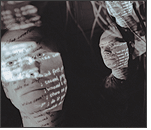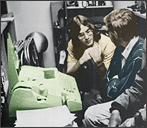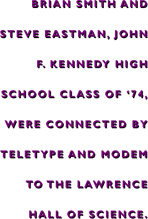

Brian Smith never needed to ask a high school guidance counselor for help in choosing a career. As a student at John F. Kennedy High School in El Cerrito, where the school's two computers, then called teletypes, were connected by modem to Berkeley's Lawrence Hall of Science, he discovered programming.
Smith had the kind of access to computers that most kids in the early 1970s could only dream of. He was a part of the science center's "Friday Project" for a small, loosely affiliated group of high school students known by staffers there as the "Frid Kids."
 The dozen or so Frid Kids had keys to the center and permission to go behind the scenes in the non-public area of Level C to learn programming on the facility's private computers.
The dozen or so Frid Kids had keys to the center and permission to go behind the scenes in the non-public area of Level C to learn programming on the facility's private computers.
The hall of science also was among the first public science centers to offer the general public access to computers.
"It was great. We were all computer geeks working together, and we learned so much," said Smith, a 1979 Berkeley graduate. He has been a programmer and systems manager in the Environmental Energy Technologies Division of the Lawrence Berkeley Laboratory for the past 20 years.
"This experience with computers had a strong influence in shaping my future career path," he added.
Stories like Smith's are music to the ears of the folks at the Lawrence Hall of Science, who, on its 30th anniversary this year, still make it their mission to wow kids into loving math and science.
Perched high in the Berkeley hills above the campus, the facility is one of the world's most distinguished public science centers.
Untold numbers of scientists, nurses, mathematicians, computer programmers, doctors, astronomers, geologists and others give credit to the center for first sparking their interest in math and the sciences.
As the chairman of the Lawrence Hall of Science, Nobel laureate Glenn T. Seaborg said of the center at its dedication in 1968 as a living memorial to Nobel laureate Ernest O. Lawrence, "The Hall, as was Lawrence, is centrally concerned with the youth, with science, and with the future."
Anne Rosinski, a hazard mitigation specialist at the Federal Emergency Management Agency, credits "the Hall" with helping her develop a keen intellectual curiosity.
"I would say that the Lawrence Hall of Science helped foster my love of science to the degree that, even though there are an awful lot of theories and concepts that are beyond my ken, I still thoroughly enjoy investigating the world around me," she said.
Ruth Freeman, a Bay Area musician, said that the hours that her sons, aged seven and 10 when the science center opened 30 years ago, spent in the public computer room there "encouraged their basic scientific awareness and ways of observing the world."
"I would drop them off Saturday morning at 9 a.m. with a dollar or a sack lunch and pick them up at 5 p.m.," she said. "Usually their lunch or the dollar was intact. They got instruction from teachers there, wrote programs, and made the computer language part of their own."
One of Freeman's sons is now a successful software entrepreneur. The other is a software engineer.
With its international reputation for such kid-pleasing exhibits as robotic dinosaurs and life-sized whales and its pioneering hands-on science and math curriculum, the center's reach is broad and impressive.
More than six million people have visited the facility since it opened 30 years ago. Over 58,000 people gawked at the moon rocks when they were displayed in 1969. Annually, 300,000 people -- including 100,000 schoolchildren -- pass through its doors.
Its 10 outreach vans take to the road to bring science and math directly to more than 250,000 Northern California and Western Nevada students. Teachers throughout California and the nation rely on the center for training and resources.
Millions of schoolchildren explore the mysteries of science using textbooks, workbooks and laboratory equipment created there. The Lawrence Hall of Science was one of the first science centers to develop elementary classroom curricula combining classroom study with laboratory techniques.
"We are pioneers, " said Larry Malone, a curriculum specialist who has worked at the facility since it opened in 1968.
"In the beginning, we were making it up as we went along," he said. "Now we have some of the best curriculum out there."
Malone's office is jammed with boxes of squirming silk moths shedding their silky cocoons, murky aquariums teeming with tiny, darting shrimp, colorful mobiles and stacks of books and files.
A biologist and Berkeley graduate, Malone is one of the authors of Full Option Science System (FOSS), a curriculum developed by the science center in 1992 for students in kindergarten through grade six. The widely used program is organized under four topics: life science, physical science, earth science, and scientific reasoning and technology. The curriculum is so versatile, said Malone, because it can be used entirely or in part.
When Malone first joined the facility's staff in 1968, the nation's scientific community was clamoring for change in science education. The Soviets had launched Sputnik, sending scientists and educators into a paroxysm of doubt over the effectiveness of the nation's math and science teaching.
"The fact that Soviets beat us into space caused real concern throughout the scientific community that we had failed," Malone said. The event prompted a series of studies, one authored by the Lawrence Hall of Science, examining how science was taught in U.S. classrooms, and it launched the first major wave of curriculum reform.
"The goal of the first wave of reform was to prepare students to become scientists," Malone said. For the first time, strict, textbook- style learning was replaced or supplemented by hands-on, interactive, experiential instruction. After the first burst of enthusiasm, however, the reform movement languished, he said.
Fast-forward a decade to 1982. The Carnegie Foundation, with Seaborg as its principal author, published the shattering report, "A Nation At Risk," prompting another serious examination of science and math education in American elementary and secondary schools.
The Lawrence Hall of Science answered the new call for reform with several innovative science education curriculums, including FOSS and the Science Education for Public Understanding Program, known as SEPUP.
Last year, more than 3.5 million schoolchildren used SEPUP materials, which focus on scientific literacy, said SEPUP Director Herbert Thier.
"We offer practical ways for learners to understand complex science and technological issues," he said.
The Lawrence Hall of Science's hands-on, interactive educational materials are the foundation of its remarkable success. First and second graders learn the basic concepts of two- and three-dimensional figures by playing with giant Tinkertoys. Enlarging a small cartoon becomes the cornerstone of a fifth grade level lesson in ratio, square numbers and proportional relationships. Kindergartners measure, mix, weigh and pour soap bubbles to understand the properties of solids, liquids, gases and scientific processes.
At its essence, the science center's mission is to instill curiosity. People use words like "awe" and "wonder" to describe their experiences there. They talk about that elusive "wow" factor -- a special person, program, class or experience that, in some cases, made them follow a career in science.
Rosinski vividly remembers seeing Lawrence's Nobel Prize, encased in glass along with a photo of the chalkboard in his classroom upon which all of Lawrence's friends had written their congratulations.
Former Frid Kid Steve Eastman, now a systems programmer for the Research Libraries Group, a small, non-profit educational corporation in Silicon Valley, recalled the awe he felt when he first saw early versions of the Macintosh computer. He saw the prenatal Macintosh, along with early models of the mouse and a graphical user interface, on a Friday Project field trip to Xerox Park, a renowned research facility in Silicon Valley.
"The Friday Project started us all dreaming," said Eastman. "We couldn't wait for the day when computers were cheap, and we could all own one.
"We were incredibly lucky," he added. "We had access to stuff that very few people could get their hands on then. That experience launched my life."
The Frid Kids met at the science center nearly every Friday for several years during the 1970s and early 1980s. Eastman said they often spent 18 hours a day, at times for entire weekends, designing software programs for the facility's computers and writing and playing computer games.
"When we were considered 'trustworthy,' we'd get a key to the Hall," Eastman said. "I remember many times eating candy bars and drinking Cokes and tinkering on the computers until the sun came up."
Eastman wrote his first program, a grade and accounting system for his John F. Kennedy High School's science department, before he received his diploma. The Lawrence Hall of Science offered Eastman his first a job as a systems programmer.
Former Frid Kid Michael Olivier, a software manager at Eastman Kodak Company, got into the Friday Project by submitting a proposal to write a program to simulate the traffic pattern of an elevator. "I spent an awful lot of time preparing that proposal," said Olivier. "I really wanted to get in."
Olivier recalled spending hundreds of hours at the science center, learning valuable skills at the computer.
"We were the luckiest ones," Olivier said. "The Hall gave us so much."
by Jacqueline Frost
![]()


[Table of Contents] [Berkeley Magazine Home] [UC Berkeley Home Page]
Copyright 1998, Regents of the University of California. All rights reserved.
Comments? E-mail ucbwww@pa.urel.berkeley.edu.